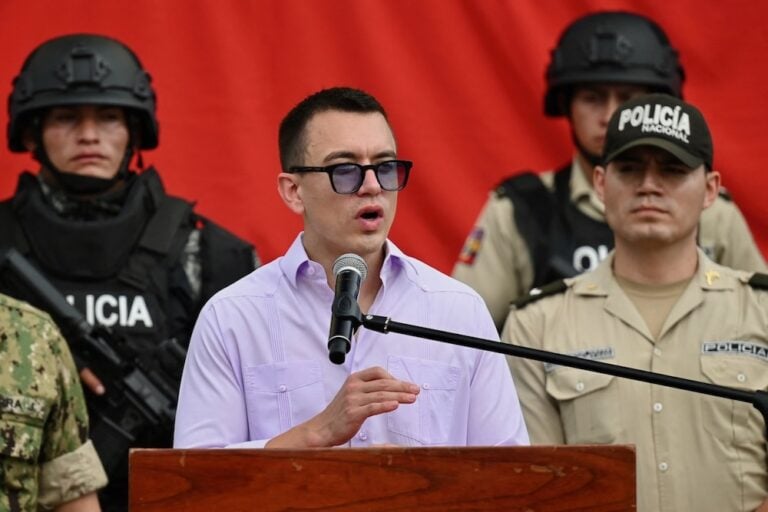Ecuadorean police responded to peaceful demonstrations commemorating International Women's Day with excessive force, including striking a journalist with a club and indiscriminate use of teargas and pepper spray.
This statement was originally published on hrw.org on 16 March 2022.
Allegations of excessive force against journalist, demonstrators
Ecuadorean police responded to peaceful demonstrations commemorating International Women’s Day on March 8, 2022, with excessive force, including striking a journalist with a club and indiscriminate use of teargas and pepper spray, Human Rights Watch said today.
On March 8, hundreds of women took to the streets, calling on the authorities to protect and guarantee their rights. They aimed to raise awareness about gender-based violence in the country, which has resulted in 28 cases of femicide so far in 2022, according to the women’s rights organization Aldea. Demonstrators also said that President Guillermo Lasso should approve a law passed by Congress in February that would guarantee access to abortion for rape victims.
“President Lasso said on March 8 that his government is working to ensure the well-being of women and a more fair and equal society,” said Tamara Taraciuk Broner, acting Americas director at Human Rights Watch. “He should start by ensuring accountability for police abuses during the International Women’s Day marches.”
On March 15, Lasso partially vetoed the abortion law and sent it back to Congress, which has 30 days to consider his proposed amendments narrowing its scope. The presidential veto undermines the work done by the Constitutional Court and the Ombudsperson’s Office, and the vote by a majority of the National Assembly, to allow Ecuadorean women and girls to reclaim their own lives after the trauma of sexual assault.
The National Assembly should uphold its commitment to protecting women and girls by maintaining the current text with no changes, Human Rights Watch said.
Human Rights Watch verified over a dozen social media posts and videos from Quito and Guayaquil that were published on Twitter, Instagram, and Youtube on March 8. Some of these show police using teargas and pepper spray against women protesters, or protesters reacting to their use. Others show police using pressurized liquid to disperse protesters. Some media outlets published similar reports, and reported police hitting protesters.
In Quito, Viviana Erazo, a journalist from the digital media outlet Wambra, was covering the protest when, she said, a police officer cornered and struck her with a club. She told Human Rights Watch she was then hit with pepper spray as she attempted to move away. Erazo recorded the whole incident, which was posted on the media outlet’s Twitter account.
These allegations match a video posted on Instagram in which Erazo is standing on a street corner recording the march with her phone, when a police officer strikes her on the back with a club. Seconds later, she appears to react to pepper spray, the sound of which can be heard in the media posting.
In another case, a woman posted an allegation on Twitter that the police had hit her and her 23-year-old daughter and used pepper spray on them. She posted a photo of a bruise on the left side of her back and told a media outlet that she had been hit on the back while she was trying to protect her daughter from the police, who were throwing gas.
Another video from Quito shows police shooting pressurized liquid at protesters standing a few meters away from them. This matches the photo of a police officer carrying the pressurized tank. The pressure causes a stinging sensation.
In Guayaquil, Valeska Chiriboga, an activist who attended the rally, told Human Rights Watch that the police used gas against protesters. She said that more than 40 women who had participated had symptoms such as vomiting, itching, and burning eyes.
In both cities, the reason why the police restricted the marches was not immediately clear. Human Rights Watch verified news reports and videos posted on social media showing police officers with shields, horses, and motorcycles blocking streets in downtown Quito to stop protesters from reaching the main square in front of the presidential palace. The police told marchers that they could not enter the square, referring to it as a “restricted area.”
In Guayaquil, police told activists they were blocking the streets, and women’s rights activists told Human Rights Watch and the media that the police kept them from moving forward, though the activists said local authorities had authorized the march. The women were later allowed to continue with their programmed events using modified routes and locations.
The national human rights secretary, Bernarda Ordóñez, said that she stood in solidarity with women, denounced the incidents, and called for investigations. No other officials criticized the police for excessive use of force.
Excessive and indiscriminate use of force by Ecuadorean security forces is not new. After protests erupted on October 3, 2019, Ecuador’s police used indiscriminate force, including firing teargas directly at protesters and at close range, causing eye injuries, or in enclosed spaces, causing asphyxiation. On May 14, 2020, police in Guayaquil used excessive force, beating and injuring peaceful demonstrators protesting the government’s handling of the Covid-19 pandemic.
Ecuador needs a law regulating the legal, proportional, adequate, and necessary use of force based on international human rights standards, Human Rights Watch said. Such a law should comply with criteria laid out in a Constitutional Court ruling adopted in May 6, 2021.
Under international human rights law, the authorities should only restrict peaceful assemblies when such restrictions are necessary and proportionate, and the least restrictive means to achieve a legitimate goal. Regardless of whether authorities deem protests unlawful, they should not use force to disperse them, but only as a last resort in response to a genuine threat.



